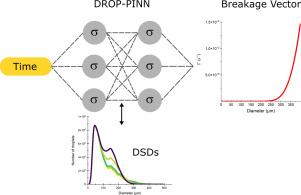Bridging experiments and models, towards a new paradigm: DROP-PINN, a physics-informed neural network to predict droplet rupture in multiphase systems
IF 7.1
Q1 ENGINEERING, CHEMICAL
引用次数: 0
Abstract
The population balance equation (PBE) is today a convenient tool to describe the evolution of multiphase systems, such as bubble plumes or columns, mixing tanks, solvent extraction columns, where they are used to infer the particle size distribution required to quantify buoyancy forces or the interfacial exchange area. However, the PBE often rely on semi-empirical models (or kernels) to predict the events likely to modify the population properties, such as breakage and coalescence. These kernels contain parameters that are tailored to specific fluid properties and operating conditions, thus limiting their general applicability (i.e. transposition to other operating conditions or processes than those used during model development). As a consequence, accurately predicting the frequency of events that modify the population of droplets remains challenging. In this study, we focus on the breakage phenomenon. Recent advances in machine learning, particularly Artificial Neural Networks (ANNs), present new opportunities for predicting the breakage frequencies. However, ANN training requires a large and high-fidelity dataset, making it time-consuming and error-prone. Physics-Informed Neural Networks (PINNs) may address this challenge by embedding physical laws into the learning process, ensuring physically consistent PBE predictions. This paper introduces a novel PINN-based algorithm that is trained to infer the droplet breakage frequencies in a turbulent agitated vessel without prior knowledge of the breakage kernel. It uses only the PBE discretized structure and a reasonable number of measured droplet size distributions obtained by in situ imaging. The methodology, we have named DROP-PINN, is first deployed and evaluated through controlled simulations, then experimentally over a wide range of dispersed phase viscosity, interfacial tension and agitation speed.

连接实验和模型,走向一个新的范例:DROP-PINN,一个物理信息神经网络,用于预测多相系统中的液滴破裂
人口平衡方程(PBE)今天是一个方便的工具来描述多相系统的演变,如气泡柱或柱,混合罐,溶剂萃取柱,其中他们被用来推断所需的颗粒大小分布,以量化浮力或界面交换面积。然而,PBE通常依赖于半经验模型(或核)来预测可能改变种群性质的事件,如断裂和聚并。这些核包含针对特定流体性质和操作条件量身定制的参数,因此限制了它们的一般适用性(即,转换到模型开发期间使用的其他操作条件或过程)。因此,准确预测改变液滴数量的事件频率仍然具有挑战性。在本研究中,我们主要研究断裂现象。机器学习的最新进展,特别是人工神经网络(ann),为预测破损频率提供了新的机会。然而,人工神经网络训练需要一个庞大而高保真的数据集,这使得它既耗时又容易出错。物理信息神经网络(pinn)可以通过将物理定律嵌入学习过程来解决这一挑战,从而确保物理上一致的PBE预测。本文介绍了一种新的基于pnp的算法,该算法可以在不知道破碎核的前提下推断出湍流搅拌容器中液滴的破碎频率。它只使用PBE离散结构和原位成像获得的合理数量的测量液滴尺寸分布。我们将该方法命名为DROP-PINN,首先通过受控模拟进行部署和评估,然后在大范围的分散相粘度、界面张力和搅拌速度下进行实验。
本文章由计算机程序翻译,如有差异,请以英文原文为准。
求助全文
约1分钟内获得全文
求助全文
来源期刊

Chemical Engineering Journal Advances
Engineering-Industrial and Manufacturing Engineering
CiteScore
8.30
自引率
0.00%
发文量
213
审稿时长
26 days
 求助内容:
求助内容: 应助结果提醒方式:
应助结果提醒方式:


